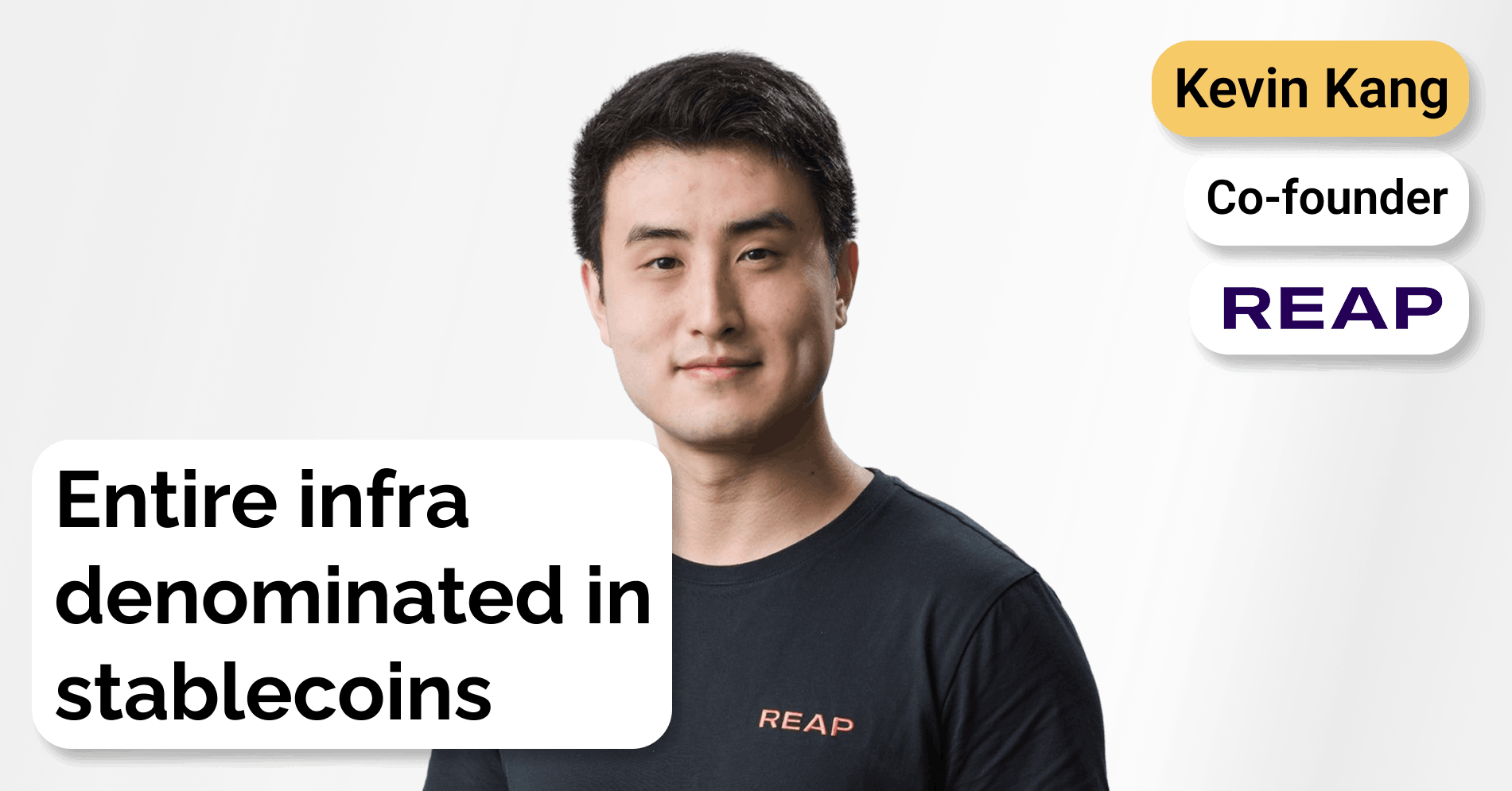Kevin Kang, co-founder of Reap, on stablecoin-native business models in fintech
 Jan-Erik Asplund
Jan-Erik Asplund

Background
We’ve covered the growing adoption of stablecoins, particularly in Latin America, through interviews with Kapital co-founder Fernando Sandoval and with Rain co-founders Farooq Malik & Charles Naut and Rail (formerly Layer2) CEO Bhanu Kohli.
To learn more about building cross-border payments and card issuance on stablecoin rails, we reached out to Kevin Kang, co-founder of Reap ($59.7M raised, HashKey Capital & Acorn Pacific Ventures).
Key points from our conversation via Sacra AI:
- Crypto-native neobanks in geographies like Latin America and Africa have begun to emerge, using stablecoins to offer USD-denominated financial services, where local currency volatility otherwise makes business planning impossible. "Our customers might be building neobanks in places like Latin America, Africa, and Southeast Asia. They build very similar products to what you would see in neobanks of the previous iteration, but their card products and payment products on the back end are being settled and transmitted and communicated by stablecoin rails, as opposed to traditional banking fintech rails."
- Twenty years ago, just as card-on-file tokenization gave rise to recurring subscription consumer businesses like Netflix & Spotify—today, instant atomic settlement on stablecoin rails unlocks business models impossible on T+2 clearing, like streaming payroll that pays by the second, instant cross-border supplier payments, and conditional money flows that execute based on real-world triggers. "A lot of people have thought about things like payroll streaming capabilities. Payday loans have been something available in places like the US, Canada, and Mexico—that could reinvent that entire ecosystem as well. Or buy-now-pay-later... We're starting to see this convergence of the platforms and fintechs building on top of us toward a better neo-banking experience, perhaps even leapfrogging what is traditionally available in more developed markets."
- Beyond monetizing payment volume, stablecoins rails enable a new tier of programmable features—multi-party settlement logic, smart-contract templates, conditional escrows—that providers like Reap ($59.7M raised, HashKey Capital & Acorn Pacific Ventures) and Bridge (acquired by Stripe for $1.1B in February 2025) can price as premium capabilities, similar to how Stripe charges for Billing, Radar and Connect atop payments. "Today, a lot of it is still driven by volume-dependent activity—how much money am I moving through various channels?... But what's exciting for us is that's starting to change a little bit... Things like building smart contracts into various ways of making money movement happen depending on certain cases or conditions, or even working with AI capabilities that are now pulling from our network to create dependencies when we're moving money. That's how we're starting to price the value-added services."
Questions
- Maybe we'll start off with the top level—if you can give us the short version of what Reap is and what inspired you to start the company.
- As I understand it, there was a traditional approach to building this kind of business initially, and then you added crypto maybe three or four years in. Can you talk about that transition?
- Can you break down a typical use case or example of a payment done on Reap? Where are the traditional payment rails, where's the crypto payment rail, and what do end users see versus what's in the background?
- When you look at companies building using stablecoins like this, what are the big improvements they get? What are they able to offer, and what are the most compelling use cases you're seeing?
- Are customers using Reap for virtually everything, or are they using it alongside other services like Stripe or Airwallex for certain flows?
- It sounds like folks are generally pairing Reap with other crypto-native or stablecoin-based tools more than traditional finance. Is that because they're positioning as crypto-based, or because they're dealing with geographies where stablecoins are essential?
- What has been the product with the most product-market fit so far? Has it been cards or cross-border B2B payments?
- Can you talk about the business model and how you monetize, and how that differs from traditional finance?
- It sounds like when you talk about convergence—converging on being a neobank—you're building a wider platform rather than going deep on one vertical. Can you speak to that, and also what the hard part is? Is it technical, or is it legal and regulatory?
- I was reading Airwallex's take on stablecoins. They don't really have a product in this space—they're waiting for stablecoins to be ready. What's your take on that? Why does Reap believe they're already ready?
- Stripe has had a big stablecoin emphasis over the last year, acquiring stablecoin companies. How does Stripe going all in on stablecoins affect how you think about what you build or the size of the opportunity in the market?
- It would be interesting to hear your market map of the space and where Reap fits in alongside potential partners like Bridge, Rain, or Rail. How do you see the landscape?
- Do you think there will be winner-take-all or winner-take-most dynamics, or will it be very dispersed, maybe by geography or use cases?
- Can you talk about Latin America? I read that it was your fastest-growing market. How do you think about geographical expansion in general, and LATAM specifically? We've heard a lot about the importance of native companies in the region being successful, but you've grown really fast there without being native.
- Is the US a compelling market, given a lot of what we've talked about around wanting people to get access to the US dollar and cross-border payments?
- If you look forward five years into the future and everything goes right for Reap, what does Reap become at that point, and how is the world different as a result?
Interview
Maybe we'll start off with the top level—if you can give us the short version of what Reap is and what inspired you to start the company.
We started about seven years ago in 2018, originally based here in Hong Kong, but we have expanded internationally since then. The original vision was increasing access to financial services and capabilities to tech builders and fintech companies around the world.
When we first started, we didn't have as clear a vision of how we were going to do that. But what we realized was that in the regions we were building out of—these financial hubs outside of the US like Hong Kong, New York, and London—there were a lot of capabilities that people were not tapping into as effectively.
These are where all the big banks, the financial networks, and the fintechs congregate. As a result, there are second-order effects around card issuance, cross-border money movement, and virtual banking that could be exported and tapped into by more businesses around the world.
We wanted to provide businesses of all sorts with the financial connectivity and access that we had access to. For example, if I land here in Hong Kong or Singapore and open a personal bank account, all of it is multi-currency from day one. I can hold 10 different currencies out of the box.
That's something even folks in the US don't think about that often. Multi-currency there is US dollar, Canadian dollar, and Mexican pesos, maybe. These are things that a lot of us here just took for granted, and we wanted to provide that to the world via technology. That was the reason we started in 2018.
As I understand it, there was a traditional approach to building this kind of business initially, and then you added crypto maybe three or four years in. Can you talk about that transition?
The implementation of stablecoin technology started around five years ago. We started the business in 2018 and started really looking into stablecoin technology around 2020. We generally don't like the labels of tradfi and non-tradfi because, at the end of the day, we were thinking about what is the best way to get these capabilities into the hands of our customers, which ended up becoming fintechs.
We thought about it from a first-principles perspective. Historically, if you're building around traditional banking rails, there's this idea of cross-border settlement where everything is seen as a regional or country-specific service. We looked at stablecoins as a way of breaking that mold. It allows the money movement and transmission of messages across this network in a more borderless and seamless way.
Ultimately, payments is a method of communication—a messaging system. I tell you I've sent A, and then you tell me that you've acknowledged and accepted A. There's a whole bunch of things behind that, but we applied that concept to blockchain and stablecoin technology, and we thought it was a really good fit for what we were trying to do.
For us, it was embracing this as a form of technology, as a way of delivering the same solutions to customers but using a different network and fundamental capability. That's why we started embracing stablecoin technology.
Can you break down a typical use case or example of a payment done on Reap? Where are the traditional payment rails, where's the crypto payment rail, and what do end users see versus what's in the background?
It depends on what you mean by end users. A lot of our customers today are businesses and platforms utilizing our capabilities to build experiences for their end users.
When we first started, that fell more into people who were embracing stablecoin and crypto technology—crypto wallets or centralized exchanges—because they already knew the capabilities and were working with this on the back end.
But over the last few years, a lot has shifted to them building traditional fintech use cases for their end users while leveraging stablecoin technology to interact with infrastructure providers and the actual money movement capabilities themselves.
Our customers, at the platform level, directly interface with us and tell us how and when to move money. We use stablecoin technology to transmit that message instantaneously, in real time, in a much more cost-efficient manner than interfacing with the traditional Swift messaging network.
We're going to places that the Swift network capabilities aren't extended to. We're almost an extension of money movement capability but on a better network in a lot of these other geographies.
Our customers might be building neobank use cases in places like Latin America, Africa, and Southeast Asia. They build very similar products to what you would see in neobanks of the previous iteration, but their card products and payment products on the back end are being settled and transmitted and communicated by stablecoin rails, as opposed to traditional banking fintech rails.
When you look at companies building using stablecoins like this, what are the big improvements they get? What are they able to offer, and what are the most compelling use cases you're seeing?
Going back to the original thesis, we were trying to democratize access to financial products that we take for granted in more developed financial markets—things centered around having a stable currency and getting access to payment methods like cards, bank transfers, and cross-border payment rails.
What they're building on top of what we provide is ultimately that capability. If you're building a neobank, you're building with similar capabilities around cards, payments, and virtual accounts, but for a geography or jurisdiction that historically has been hard to get access to that infrastructure because they can't build domestically.
If you're talking about a country where some of the larger, more international banks don't operate, how are you going to get a card infrastructure issuer provider to help build for you there? You have to import that capability from a place such as Hong Kong, Singapore, or the US, and that's what we're providing.
The ultimate end offering is not that dissimilar. If you're sitting in the US, Chime or Revolut might have these capabilities, but you're now able to offer all of that in places where historically it's been harder to build with the existing infrastructure providers.
Are customers using Reap for virtually everything, or are they using it alongside other services like Stripe or Airwallex for certain flows?
It's a hybrid. But I wouldn't say it's a hybrid of a player like us and folks that are more traditional. There are various different verticals of capabilities. The things we specialize in around stablecoins is essentially money in motion—moving value and funds from point A to point B and all of the ancillary value-added services around that.
That said, there are other things that when you're building a fintech, you converge toward. People want lending, people want investments, people want various sorts of personal wealth management, insurance, et cetera. There's a lot of these other verticals that some of our customers are also looking for, also built on stablecoin rails.
That's something really exciting—even though we focus on the money in motion part, there are these additional layers of financial products being built on top of this stablecoin economy that we're taking advantage of.
We're starting to see this convergence of the platforms and fintechs building on top of us toward a better neobanking experience, perhaps even leapfrogging what is traditionally available in more developed markets.
It sounds like folks are generally pairing Reap with other crypto-native or stablecoin-based tools more than traditional finance. Is that because they're positioning as crypto-based, or because they're dealing with geographies where stablecoins are essential?
It's more of the latter. If you're building for a region where a company like Stripe or Airwallex would be harder to operate in, and your entire infrastructure and system and ledger is denominated in stablecoins, you want to keep all of your service providers native to that technology as well.
If my ledger is denominated in USDC or USDT, then I want my card issuer to work with those currencies. I want my yielding and savings services provider to work with those currencies as well. It would be very hard for them to co-mingle the two sets of technologies together to provide these services.
At the end of the day, it's about how they're building and what type of technology they choose to build on.
What has been the product with the most product-market fit so far? Has it been cards or cross-border B2B payments?
Because we serve a pretty wide set of customers, it really depends on the segment. If you're talking about retail, neobanking, or digital wallets that are more consumer-focused, the types of spend still focus more on cards because that's more widely accepted.
The card schemes and networks are accepted in over 190 different countries, so it works better for that type of proposition.
But for B2B, it starts more with direct-to-account types of payments—cross-border remittances, bypassing some of the existing Swift infrastructure to send directly into the bank accounts of suppliers, employees, et cetera.
We're starting to see a convergence. Our view is that if you're building for any kind of fintech, you converge toward this need for neobanking. If you start with cards on the consumer side, they will eventually want P2P capabilities and direct-to-wallet capabilities, so payments become very important.
From the payments side, platforms like business banking platforms similar to Airwallex are also building from payments toward corporate cards and expense management. The underlying set of tools you need to build fintechs is ultimately converging, but where people start might be different depending on the customer segment they're trying to serve. On the consumer side, it would be more cards, and on the B2B side, more payments.
Can you talk about the business model and how you monetize, and how that differs from traditional finance?
Today, a lot of it is still driven by volume-dependent activity—how much money am I moving through various channels? Because we focus on money in motion, it's largely driven by the amount of dollars flowing through the card networks that we're powering and the amount of volume flowing through cross-border B2B payments. There's an element of FX and some things that are more akin to traditional analogs.
But what's exciting for us is that's starting to change a little bit. If we look maybe two to three years in the future, it's more about the programmability of the network. Fundamentally, we are upgrading the network to be more digitally native. If you're working with a better system, you can create things like conditionals and software on top of that network, which is also monetizable.
Things like building smart contracts into various ways of making money movement happen depending on certain cases or conditions, or even working with AI capabilities that are now pulling from our network to create dependencies when we're moving money.
That's how we're starting to price the value-added services, and that's where it becomes a little bit more different from traditional analogs. It's almost like charging for incremental multi-media capabilities on top of the network. If you're drawing the analogy to a messaging network, we're going from SMS to WhatsApp that is now able to support a lot more payload every time you're sending funds through the upgraded infrastructure of stablecoins.
It sounds like when you talk about convergence—converging on being a neobank—you're building a wider platform rather than going deep on one vertical. Can you speak to that, and also what the hard part is? Is it technical, or is it legal and regulatory?
First of all, underneath the hood, it's all one technology. From that, you can branch various different verticals. At the end of the day, if you're thinking about this as a technology, you can use that infrastructure to code for money movement on cards, on traditional rails, and even future rails like direct-to-wallet.
You're not necessarily bifurcating and diverging into all of these different verticals to create something entirely new. What's powerful about this is because it's so programmable, you can program it to do various different things.
Because of that, it allows for a lot more scalability and modularity. If you want to build for a neobank with a different flavor, you could still use the same fundamental tools but create your own spin on top of it for a certain geography, for a certain type of customer, add rewards on top of that. That's what's exciting for us.
To answer your second question about what is the most difficult thing: from a technological perspective, it's building this toolbox. Everybody has different things they want to build, so what we're fundamentally building is the toolbox for them to be able to create those things. To create the best toolbox, you have to have the fullest suite of capabilities.
You don't just want a hammer and a screwdriver because then you can't really do that many things. But if you can create multipurpose tools for every single one of these capabilities, then our customers can go build a chair or a house. It becomes a lot more flexible and modular in nature.
On the regulation side, it's really important for us because that feeds into how we build some of these things. It's a constant feedback loop. We want to build something, we talk to the regulators, we explain that this is something relevant for the market and important for serving consumer demand.
They tell us what they are worried about, and we get back to them. It's a constant feedback loop. I wouldn't say that's necessarily the most difficult part of what we're doing. It's more about communicating the right message and figuring out what the market actually needs and how we can do it within the framework of regulation.
I was reading Airwallex's take on stablecoins. They don't really have a product in this space—they're waiting for stablecoins to be ready. What's your take on that? Why does Reap believe they're already ready?
It's very hard for me to speak specifically around why they've taken that stance or if that stance is evolving, because I can't speak for them. But for us at Reap, the reason we believe in it is because of what that technology actually solves.
If you think about our problem space—delivering financial capabilities to geographies where it's harder to develop natively and domestically—it's the best way to do it today. That's why we embrace this technology.
Fundamentally, we think about stablecoins as a means, a delivery method. We are always chasing after the best way to do these things. If tomorrow, for whatever reason, there is a better way of doing that beyond stablecoins—a better ledger system or better network for us to do this, Web 4.0, Web 5.0—as a technology company, we would still fundamentally evaluate those capabilities as well.
We would not be overly indexed on any particular rail as long as it delivers the solution to our problem space in the most efficient and cost-effective way possible.
Stripe has had a big stablecoin emphasis over the last year, acquiring stablecoin companies. How does Stripe going all in on stablecoins affect how you think about what you build or the size of the opportunity in the market?
Generally, things like how Stripe has interfaced with companies—the publicly announced acquisitions of Bridge and Privy—these are good signals for us. I don't think they specifically in of themselves mean anything to us just yet, but it is a sign of mainstream adoption.
It's a sign that technology companies such as Stripe may also consider this technology and are thinking about upgrading their networks. That means we will have more partners to work with at the end of the day.
Reap in and of itself is not the end-all-be-all of these solutions. We need to work with other people. We never exist in isolation. A network is only as strong as the various different nodes and capabilities that bring up that network itself.
This is a positive signal for the market, a positive signal for what we're building, and a positive signal for our customers. What that means is there will be continued support and a lot more investment into the space, and we like that.
It would be interesting to hear your market map of the space and where Reap fits in alongside potential partners like Bridge, Rain, or Rail. How do you see the landscape?
It's not about any specific name. Everybody is focused on what they're focused on. Specifically here at Reap, we're focused on establishing the base layer of that network itself—money movement and money in motion—to create the value transfers between various spheres and different nodes. Our goal here is to get that adoption as much as possible.
Our view of this in terms of stablecoin money movement is really a tokenized future where a lot of value creation will be done via tokens across multiple different types of financial assets. That's something a lot of these other folks are also building toward.
I wouldn't say it's a map where everything fits nicely with each other, overlapping right next to each other. It's rather a very open, blue ocean type of situation where everybody's building for it, and we haven't converged just yet. It's hard for us to say where things are going to end up. But we are focused specifically on increasing the adoption of that network and increasing the money movement capability on stablecoin rails.
Do you think there will be winner-take-all or winner-take-most dynamics, or will it be very dispersed, maybe by geography or use cases?
If I had to pick one, there's probably going to be multiple winners in this space, but I don't think it's going to be segmented by something like geography. The reason is because the technology is so inherently borderless. It really allows for people to build a specific capability or multiple capabilities across a lot of different geographies. That's the whole point of utilizing this network that can be borderless.
That said, you might have people who focus on lending, people who focus on savings, people who focus on different parts of the pieces in terms of capabilities. That's where it will start to differentiate a little bit. We want to be really focused on being the best money movement capability specifically on this network.
Can you talk about Latin America? I read that it was your fastest-growing market. How do you think about geographical expansion in general, and LATAM specifically? We've heard a lot about the importance of native companies in the region being successful, but you've grown really fast there without being native.
We have folks on the ground—in Brazil, we have over 12 people now, and in Mexico, about six or seven. One of the things that is really exciting about working with borderless technology is you can really focus on what the problems are and what problems you're solving specifically for customers.
Access to a more globally accepted currency like USD via stablecoin is really important in some of these regions we're growing fast in, like LATAM. They want to get access to that currency not specifically because they just want to hold US dollars per se, but more related to the characteristics and capabilities of something like a US dollar—the ability to have stability and to utilize that currency to buy other financial services that they historically may not have had access to. It's really a means to an end. That's why places like Africa and Southeast Asia have been very fast-growing for us.
LATAM specifically also has the additional lens of being favorable from a regulatory perspective. They foster a lot of fintech adoption and fintech growth. The businesses being grown out of some of those LATAM countries are also very forward-thinking because they have this ecosystem that allows them to adopt new technologies like stablecoins.
They're able to get to that mainstream adoption a lot faster than we've seen in other places where they don't need to—where they may have access to the Swift networks and more global international banks locally. We're seeing a lot more innovation out of these regions as well, which makes us more excited to be building for those places.
Is the US a compelling market, given a lot of what we've talked about around wanting people to get access to the US dollar and cross-border payments?
Nothing exists in isolation. Every market is important for some reason. I see places like the US and where we operate out of—Hong Kong and Singapore—as more of the supply side of this equation, where the solutions can be built out of.
Once again, the banks and the existing traditional infrastructure were originally from there. If we elevate that and try to export some of those capabilities, those are where our raw ingredients and inputs may come from. It's very important to be able to work in some of those geographies and to work with networks and fintechs to create the capabilities that we're then powering via the APIs. But our end users may not always be sitting there.
That said, in the future, because of the modularity of this technology and infrastructure that we're building, there could be some new end-user modality that we haven't even thought of. A lot of people have thought about things like payroll streaming capabilities. Payday loans have been something available in places like the US, Canada, and Mexico—that could reinvent that entire ecosystem as well. Or buy-now-pay-later.
There's a lot of different things that could still be applicable on the user end of the stablecoin technology. But today, it's where we are exporting the capabilities out of—out of a place like the US, out of a place like Hong Kong and Singapore.
If you look forward five years into the future and everything goes right for Reap, what does Reap become at that point, and how is the world different as a result?
We are fundamentally a technology company, which means we don't like to overly prescribe the potential use cases. That's why we focus on building these tools. We think that if you build the best tools, then people can create things you can't even imagine.
We don't want to overly index on what some of these capabilities necessarily may be. But in the next five years, if we are successful, then we have built all of this underlying layer for people to create—for people to come up with new versions of neobanks, new versions of lending and savings capabilities, new versions of money movement that we haven't even thought of just yet.
It really leverages how efficient and scalable things like value movement on stablecoin technology can be—things like atomic settlements that the last generation of fintechs were not capable of accessing. They can now access them, and maybe that can result in various sorts of apps being built on the consumer and the business side.
We draw this comparison to how people adopted online payments in the last iteration of technology adoption. Think about things like saving your card on file to be able to pay for recurring subscription charges like Netflix or Spotify.
That was a result of the internet. That was a result of being able to tokenize a card payment method and store it on file so you can keep charging it recurrently without having to type in that number every time a bill comes due. That technology has only been around for maybe 20 years.
If we extrapolate that type of creative thinking to a newer network that has even more capabilities around tokenization, programmability, and digital-native capabilities, who knows what that new business model might be in the next 20 years that can be built on top of that. If we are successful, we will have enabled all of those businesses to be created, to evolve, and to operate in the next five years.
Disclaimers
This transcript is for information purposes only and does not constitute advice of any type or trade recommendation and should not form the basis of any investment decision. Sacra accepts no liability for the transcript or for any errors, omissions or inaccuracies in respect of it. The views of the experts expressed in the transcript are those of the experts and they are not endorsed by, nor do they represent the opinion of Sacra. Sacra reserves all copyright, intellectual property rights in the transcript. Any modification, copying, displaying, distributing, transmitting, publishing, licensing, creating derivative works from, or selling any transcript is strictly prohibited.





